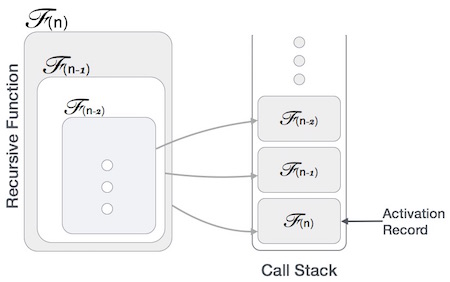Some computer programming languages allow a module or function to
call itself. This technique is known as recursion. In recursion, a
function α either calls itself directly or calls a function β that in turn calls the original function α. The function α is called recursive function.
Example − a function calling itself.
This implies, the caller function has to suspend its execution temporarily and resume later when the execution control returns from the callee function. Here, the caller function needs to start exactly from the point of execution where it puts itself on hold. It also needs the exact same data values it was working on. For this purpose, an activation record (or stack frame) is created for the caller function.
 This activation record keeps the information about local variables,
formal parameters, return address and all information passed to the
caller function.
This activation record keeps the information about local variables,
formal parameters, return address and all information passed to the
caller function.
Example − a function calling itself.
int function(int value) { if(value < 1) return; function(value - 1); printf("%d ",value); }Example − a function that calls another function which in turn calls it again.
int function(int value) { if(value < 1) return; function(value - 1); printf("%d ",value); }
Properties
A recursive function can go infinite like a loop. To avoid infinite running of recursive function, there are two properties that a recursive function must have −- Base criteria − There must be at least one base criteria or condition, such that, when this condition is met the function stops calling itself recursively.
- Progressive approach − The recursive calls should progress in such a way that each time a recursive call is made it comes closer to the base criteria.
Implementation
Many programming languages implement recursion by means of stacks. Generally, whenever a function (caller) calls another function (callee) or itself as callee, the caller function transfers execution control to the callee. This transfer process may also involve some data to be passed from the caller to the callee.This implies, the caller function has to suspend its execution temporarily and resume later when the execution control returns from the callee function. Here, the caller function needs to start exactly from the point of execution where it puts itself on hold. It also needs the exact same data values it was working on. For this purpose, an activation record (or stack frame) is created for the caller function.
 This activation record keeps the information about local variables,
formal parameters, return address and all information passed to the
caller function.
This activation record keeps the information about local variables,
formal parameters, return address and all information passed to the
caller function.
No comments:
Post a Comment